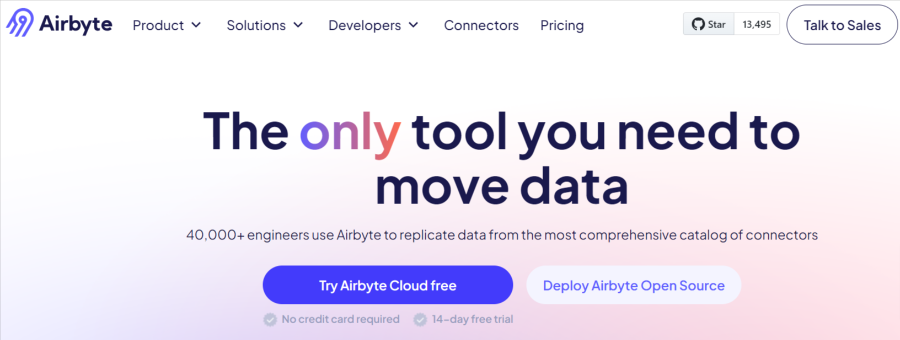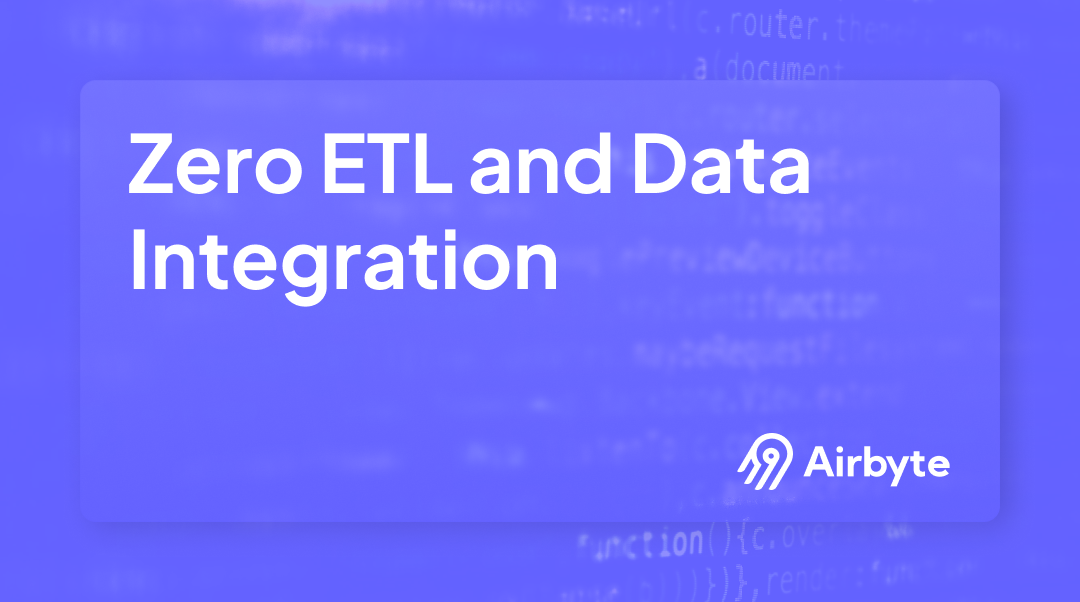What is Zero ETL and How Does it Transform Data Integration?
Extract, Transform, Load (ETL) might traditionally be a scalable solution for data migration, but many new approaches are taking over it. For instance, most data organizations use ELT instead of ETL for more efficiency.
However, organizations are also exploring new ways to enhance the workflow through Zero ETL. Zero ETL is the latest approach to shaking up the data integration landscape. It can transform businesses into a new phase of real-time data analytics to enhance decision-making.
In this article, we will discuss zero ETL in detail, and you will learn its components, benefits, use cases, and more.
What is Zero ETL?
Zero ETL, as the name suggests, is a process that eliminates the need for ETL in data management tasks. Instead, it allows you to query and analyze data directly from disparate data sources in real time without extensive preprocessing or intermediate data storage. Zero ETL takes a non-conventional approach to data replication by directly querying and leveraging data from different sources in their original format.
The process also aims to move and analyze data from source systems to target systems with minimal transformation tasks so that you can focus more on deriving insights. Therefore, you can take zero ETL into consideration when you want to migrate data quickly without performing complex transformations.
However, the catch with zero ETL is it comes with its complexities. You need a team of experts and professionals to achieve this data management approach.
Components of Zero ETL
To understand more about zero ETL, let's learn about some of the key components of the process:
Data Sources
Data sources are where the data comes from. They can include databases, flat files, IoT devices, APIs, and more. Data sources are a foundational component of zero ETL, as the process directly extracts data from these sources without performing transformation. After extraction, the data from data sources is replicated into the target system in its native format.
Data Lake Architecture
Since the data is not transformed, data lakes are crucial parts of a zero ETL strategy. They store raw, untransformed data and allow you to apply transformations on the fly while the data is extracted for analysis. However, Zero ETL also works with a data warehouse, where you can store the raw data without transformation.
Schema-On-Read Engine
Unlike the traditional ETL process, zero ETL follows a schema-on-read approach for data processing. The schema-on-read engine does not enforce a predefined schema during data replication and interprets the data structure while analyzing. This provides more customizability and flexibility when integrating data in raw form.
Data Analysis Technologies
The zero ETL process also includes a suite of tools for data analysis, such as querying, transforming, and analytics. This layer can include programming languages, frameworks, technologies, and tools. Here are some of the examples of each:
- Programming Languages: Python and SQL.
- Frameworks: TensorFlow and scikit-learn.
- Technologies: Data virtualization and data federation.
- Tools: Power BI, Apache NiFi, and Tableau.
How to Perform Zero ETL Integration?
Zero ETL integration is straightforward to perform. Before starting the process, consider the prerequisites for this integration: data sources and target storage system.
To create zero ETL integration, specify an integration source and a target system. Let's take a Redshift data warehouse as the target system. Now, connecting any two operational systems will make the data available in Redshift within minutes. Notice that we have not performed any transformation or processing steps and have only replicated data in native format.
Now that data is in Redshift, your target system, you can choose to perform analytics and business intelligence tasks. You can use the data analysis technologies discussed above or Redshift's built-in features. Redshift provides:
- Built-in machine learning.
- Materialized views.
A zero ETL integration will isolate your compute resources from data resources, allowing you to use the most efficient tools for processing data.
And that's it. This is briefly all you must do to perform zero ETL integration.
Benefits of Zero ETL
Zero ETL has a lot of benefits that serve the evolving need for real-time analytics and high-data-quality maintenance. Some of the key ones are mentioned below:
Basic Data Transformation
Unlike the conventional approach to data replication, zero ETL allows you to perform integration without data transformation or complex preprocessing logic. This is the biggest advantage for data professionals, as you don't have to perform many tasks like data aggregation, manipulation, mapping, and more. However, this doesn't mean total elimination of data transformation. There are still some of the transformation practices that you need to take care of in zero ETL
Real-Time Insights
ETL processes often involve periodic batch updates, which causes latency and delayed data availability. Zero ETL does the opposite. It provides real-time data access to ensure fresh analytics, AI/ML, and reporting data. This gives you more accurate and timely insights, which can be helpful for use cases like customer behavior analysis and real-time dashboards.
Enhanced Data Quality
By eliminating data transformation with zero ETL, you can maintain data quality throughout its lifecycle. You can apply data cleansing and validation techniques as part of the analysis process to ensure that only high-quality data is used for decision-making. This results in more accurate insights and improved data quality.
Cost Efficiency
Zero ETL allows you to skip many data management tasks and utilizes cloud-native and scalable data integration technologies. This optimizes the cost of data integration based on actual usage and data processing requirements and allows you to reduce infrastructure costs and maintenance overheads.
Use Cases of Zero ETL
Here are some of the key use cases of zero ETL:
Real-time Replication
Zero ETL offers the functionality of a data replication tool that instantly duplicates data from a transactional database to a data warehouse or lake. By eliminating the need for complex ETL processes and ingesting data directly into a centralized repository, zero ETL allows for real-time replication.
Federated Querying
Federated query allows you to query various data sources without actually moving data. You can leverage zero ETL to perform federation by using SQL commands to join data across sources and run queries across different sources in real-time.
IoT Data Processing
Zero ETL is ideal for processing data streams in IoT devices in real-time, as it doesn't include complex preprocessing for data ingestion. This process can be used for data analysis with IoT devices as you get predictable data types and volumes. Eliminating the need for complex transformations before analysis.
Streamline Zero ETL with Airbyte
Now that you know about zero ETL, you might want to use it practically. However, performing zero ETL with custom coding can be challenging and requires expertise and resources. That's where tools like Airbyte can help.
Airbyte is a data integration tool that follows a modern ELT approach for connecting different data sources to destinations. The platform has the largest catalog of pre-built connectors, numbering over 350+. While performing zero ETL, you can use these connectors to automate data integration from any data source to target systems.

However, connectors are not all. Airbyte offers cutting-edge features like orchestration capabilities, robust security, and a compliance certificate to streamline your zero ETL integration.
Key features of Airbyte include:
- Custom Connectors: If you don't find the required connectors for data sources or target systems, Airbyte can solve this issue. It offers a feature to create custom connectors using its connector development kit, which has an intuitive user interface that enables you to create your custom connectors within a few clicks.
- Change Data Capture (CDC): The CDC feature of Airbyte allows you to track changes and updates in an operational system. It supports log-based CDC for many sources like Postgres, MySQL, and a large number of systems.
- PyAirbyte: For zero ETL, you might need customized pipelines, and PyAirbyte offers them all. It is a Python library that you can use to access every Airbyte connector to fetch data with less code implementation. This simplifies the overall workflow while using Python programming to build data pipelines.
Conclusion
Zero ETL signals an important shift towards more immediate and efficient data integration. As discussed above, it has many advantages, including no data transformation, real-time insights, enhanced data quality, and cost efficiency.
By applying zero ETL integration according to your use case from the above, like enriching CRMs, federated queries, and IoT processing, you can harness the full potential of zero ETL.
However, you need extensive expertise and resources to perform zero ETL integration. Therefore, we suggest using SaaS tools like Airbyte to perform zero ETL.
Over 40,000 engineers use Airbyte to replicate data from one system to another. Join its vibrant community by signing up today!
